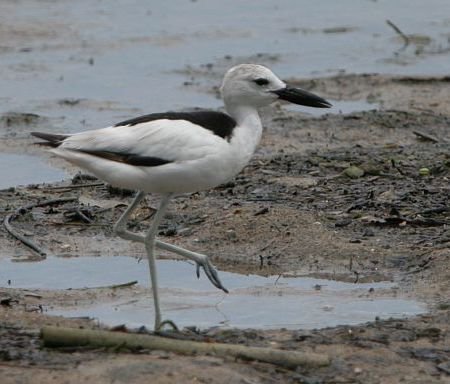Dromadidae – Crab Plover

The Dromadidae family has just one member, the Crab-plover, which is a bird related to the waders, but sufficiently distinctive to merit its own family. Its relationship within the Charadriiformes is unclear, some have considered it to be closely related to the thick-knees, or the pratincoles, while others have considered it closer to the auks and gulls. It is the only member of the genus Dromas and is unique among waders in making use of ground warmth to aid incubation of the eggs.
It resembles a plover, but has very long grey legs and a strong heavy black bill similar to a tern. Its black-and-white plumage and long-necked upright posture with heavy bill makes it distinctive and unmistakable. Its bill is unique among waders, and specialised for eating crabs. It has partially webbed toes. The plumage is white except for black on its back and in the primary feathers of the wings. They are noisy birds, calling frequently on their breeding sites and in their wintering grounds. The usual call is a ka similar to that of the Bar-tailed Godwit but repeated rapidly. Flocks may produce a whinnying sound that rises and at in the breeding season produce whistling kew-ki-ki notes.
Males and females are not easily distinguished but males have a heavier and longer bill. Juveniles have the black on the mantle, greyish and remain in this plumage for a year. Flocks fly in lines or “V” formations. The Crab-plover is one of the species to which the Agreement on the Conservation of African-Eurasian Migratory Waterbirds (AEWA) applies.
The crab-plover is unusual for waders in that it nests in burrows in sandy banks. In the Red Sea region, the breeding season begins around the middle of May. It is a colonial breeder, nesting in colonies as large 1500 pairs. It lays one white egg, occasionally two, which are large for its body size. The nest burrow temperature is optimal due to solar radiation and the parents are able to leave the nest unattended for as long as 58 hours. The chicks are also unique for the usually nidifugous waders in being unable to walk and remain in the nest for several days after hatching, having food brought to them. Even once they fledge they have a long period of parental care afterwards. Both males and females take care of the young.
This family has just one species, which is:
Crab Plover Dromas ardeola
-
Cab Plover Dromas ardeola
Species AccountThe Crab Plover (left & above) is a dramatic wader of tidal mudflats around the Indian Ocean. Its distribution is very localized. Indeed, only nine nesting colonies are known in the entire world! Over 1500 pairs nest in Iran, 300 pairs breed in the United Arab Emirates (where these photos were taken), 85 pairs in Oman, 110 pairs in Saudi Arabia, and an unknown number in Somalia (Rands 1996). It is an odd bird in many ways. Its pied plumage recalls avocets but it nests in burrows and its heavy bill is like those on Great Thick-knee Esacus recurvirostris or Beach Thick-knee E. magnirostris. Like those latter species the Crab Plover feeds almost exclusively on crabs, greedily dismembering the unlucky prey it finds at low tide… -
Crab Plover Dromas ardeola
BirdLife Species AccountFull species account.... -
Crab Plover Dromas ardeola
Species AccountThe crab-plover or crab plover (Dromas ardeola) is a bird related to the waders, but sufficiently distinctive to merit its own family Dromadidae. Its relationship within the Charadriiformes is unclear, some have considered it to be closely related to the thick-knees, or the pratincoles, while others have considered it closer to the auks and gulls. It is the only member of the genus Dromas and is unique among waders in making use of ground warmth to aid incubation of the eggs... -
Crab Plover Dromas ardeola
IUCN Species Status -
Crab Plover Dromas ardeola
Species AccountSound archive and distribution map.
-
Number of bird species: 1
-
Shorebirds
| (An Identification Guide to the Waders of the World) | by Peter Hayman, John Marchant & Tony Prater | Christopher Helm | 1991 | Hardback | 416 pages, 88 colour photos, 214 maps, line drawings | ISBN: 9780713635096 Buy this book from NHBS.com -
Waders of Europe, Asia & North America
| By Stephen Message & Don Taylor | Christopher Helm | 2006 | 224 pages, 80 plates with colour illustrations | ISBN: 9780713652901 Buy this book from NHBS.com
-
International Wader Study Group
WebsiteThe International Wader Study Group (IWSG) is an association of amateurs and professionals from all parts of the world interested in Charadrii (waders or shorebirds). Membership of the WSG is currently over 650 worldwide. Members can be found in over 50 countries around the world, including all European countries and the Americas, Asia, Africa and Australasia. The interests of the group have diversified from its original focus from ringing and migration-related studies to embrace all aspects of wader biology.
-
The New Shorebirds Handbook Project
BlogThis is a blog of The New Shorebirds Handbook Project which aims to bring together the current knowledge on shorebird science, conservation and a little bit more. By following the blog, readers could insight into the progress and important milestones of the project and the recent news on the world of waders and a bit more of us, the authors….
